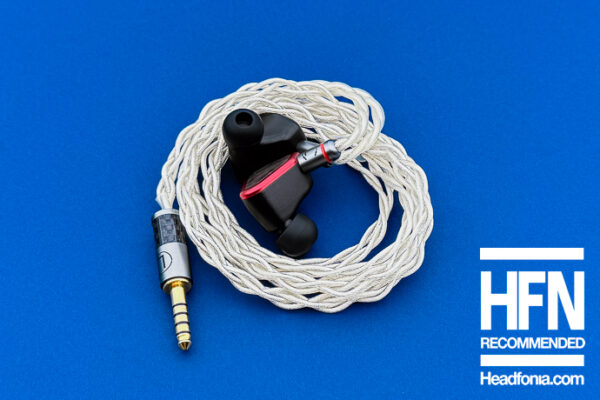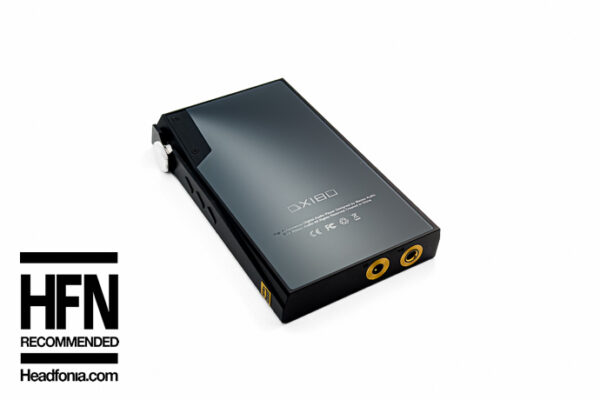In terms of fitting, the e-Q7 is very good, and among the best in IEMs. The SE530, with the stiff cable is quite inferior to the e-Q7’s cable, though the newer SE535 might change all that. The fabric covered cable in the e-Q7 is flexible enough for portable use, but the fabric covering seems to provide very good resistance to tangling. Among all the IEMs that I have in my possession at the moment (about 11 of them), the e-Q7’s is the only one that never gets tangled. Awesome, because I don’t have to untangle the cables everytime I want to listen to them.

The cable has a fabric cover after the Y-split, giving a rather luxurious feel and resistance to tangling.

Among all the other IEMs, the Ortofon e-Q7 is the only one with the fabric covered cable. From 12 O'clock: Etymotics HF5, Shure SE530, JHAudio JH5Pro, Ortofon e-Q7, JAYS q-Jays, Westone 2, and Fischer DBA-02 in the center.
I did mention earlier that the e-Q7 sounds like it’s permanently attached to a tube amplifier. Yes, as a matter of fact, I didn’t know that an IEM can have such a heavy mellow coloration without the aid of an amplifier. That’s really good in a sense, because you have quite a specialty tool that sounds very good, and especially good for mellow vocals. I know a lot of people who listens mostly to female vocals, and the e-Q7 is just the perfect IEM for them. Female vocal recordings tend to have a good amount of sibilance in them, and the e-Q7 has one of the most effective sibilance filter among all the IEMs that I’ve heard.
But if you’re not an extreme female vocal lover, then I would recommend the SE530 over the e-Q7. The SE530’s frequency balance is quite similar and just as wonderful, and it’s quite superior in transient speed, soundstage and detail. Not only that, I find the SE530 to have enough energy for classic and alternative rock, where the e-Q7 is just too mellow for those genres. So, the e-Q7 is a bit limited in that sense (notice I used the phrase “specialty tool” in the paragraph above).
I probably won’t make a big deal out of the technical performance if the e-Q7 was priced at the same level as other single driver IEMs. But somehow, Ortofon priced their product at the $300 price point, and then it’s only natural to compare the e-Q7 to something in that price point. At $300, its quite a musical IEM, but it’s magic is less felt when you start to listen to other genres. But if you’re a die hard vocal lover, then $300 for an IEM that does mellow vocals best is probably a reasonable amount of money to spend, because even my JH16 doesn’t do mellow vocals the way the e-Q7 does.
Gear used for review:
IEMs: Ortofon e-Q7, Shure SE530, Jays q-Jays
Source: Ipod Nano 5th Gen
Amp: HeadAmp Pico Slim








Noir
Great review there, even if i haven't auditioned at least i got the impression before buying it.
if its true that it tuned for asian/japanese music then i'll be happy to buy it since almost 95% of my library are japanese music.
Mike
I wouldn’t say “tuned for asian/japanese music”, but it does have a mellow character that suits female vocals very well.
HC
Hi Mike,
Thanks for the review.
May i know how do they compare against the Klipsch Image X10?
Mike
Hi HC, sorry, no experience with the X10. 🙁
Alexei
Hi, guys im translating this article into russian for my friends. Could you explain with more details the meaning of word “transients”. Perhaps some synonyms or something like that. Thanks in advance. From Russia with respect.
Anonymous
Hi Alexei,
Thanks for the effort for doing the translation.
I tried using Google Translate and come up with some words in Russian
that I am not sure what it says:
http://translate.google.com/#en|ru|transients%0A
Anonymous
If you take a cymbal and hits it, it would make a “crash” sound.
A fast transients would be “crash!” and that’s it.
A slow transients would be something like “crrrrasssshhhhh”.
Or say you have three instruments playing together at the same time.
Fast transients would be “crash! boom! bang!”. Every instrument is clear
and distinct.
Slow transients would be “crrrrashshhsbbbbbooombmbbmbaaaanngggggg”. The
instruments are mingled together and doesn’t sound distinct.
Hope that makes sense 😉